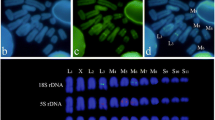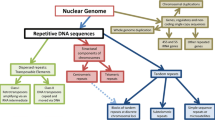Abstract
A short interspersed nuclear element (Can SINE) of ∼130–150 bp was cloned and characterized from Canis familiaris. We demonstrate that this element is interspersed, present approximately every 5–8.3 kbp, and many are sufficiently close to allow IRS (interspersed repetitive DNA sequences) PCR. Sequence analysis of > 20 Can SINEs from the dog has identified a conserved region that was used to design oligonucleotides for IRS PCR. Since Can SINEs are not present in human or rodent genomes, IRS PCR using oligonucleotides directed to the conserved region of Can SINEs can be used to simplify analysis of canid DNA in somatic cell hybrids, as well as in large insert cloning vectors. We demonstrate that the canid IRS products are polymorphic and could be developed as genetic markers for filter-based genotyping in this organism.
Similar content being viewed by others
References
Benton WD, Davis RW (1977) Screening λgt recombinant clones by hybridization to single plaques in situ. Science 196, 180–182
Brooks-Wilson A, Smailus DE, Weier H-UG, Goodfellow PJ (1992) Human repeat element-mediated PCR: cloning and mapping of chromosome 10 DNA markers. Genomics 13, 409–414
Chumakov IM, Le Gall I, Billault A, Ougen P, Soularue P, Guillou S, Rigault P, Bui H, de Tand M-F, Barillot E, Abderrahim H, Cherif D, Berger R, Le Paslier D, Cohen D. (1992) Isolation of chromosome 21-specific yeast artificial chromosomes from a total human genome library. Nature Genet 1, 222–225
Coltman DW, Wright JM (1994) Can SINEs: a family of tRNA-derived retroposons specific for the superfamily Canoidae. Nucleic Acids Res 22, 2726–2730
Deininger PL (1989) SINEs: short interspersed repeated DNA elements in higher eukaryotes. In Mobile DNA DE Berg, MM Howe, eds. (Washington, DC: Am Soc Microbiol), pp 619–636
Deininger PL, Jolly DJ, Rubin CM, Friedmann T, Schmid CW (1981) Base sequence studies of 300 nucleotide renatured repeated human DNA clones. J Mol Biol 151, 17–33
Fischer PE, Holmes NG, Dickens HF, Thomas R, Binns MM, Nacheva EP (1996) The application of FISH techniques for physical mapping in the dog (Canis familiaris). Mamm Genome 7, 37–41
Francisco LV, Langsten AA, Mellersh CS, Neal CL, Ostrander EA (1996) A class of highly polymorphic tetranucleotide repeats for canine genetic mapping. Mamm Genome 7, 359–362
Fuhrman SA, Deininger PL, La Porte P, Friedmann T, Geiduschek EP (1981) Analysis of transcription of the human Alu family ubiquitous repeating element by eukaryotic RNA polymerase III. Nucleic Acids Res 9, 6439–6456
Guzzetta V, Montes de Oca-Luna R, Lupski JR, Patel PI (1991) Isolation of region-specific and polymorphic markers from chromosome 17 by restricted Alu polymerase chain reaction. Genomics 9, 31–36
Hastie ND (1989) Highly repeated DNA families in the genome of Mus musculus. In Genetic Variants and Strains of the Laboratory Mouse, MF Lyon, AG Searle, eds., (London/New York: Oxford Univ. Press), pp 559–573
Hunter KW, Ontiveros SD, Watson ML, Stanton Jr VP, Gutierrez P, Bhat D, Rochelle J, Graw S, Ton C, Schalling M, Aburatani H, Brown SDM, Seldin MF, Housman DE (1994) Rapid and efficient construction of yeast artificial chromosome contigs in the mouse genome with interspersed repetitive sequence PCR (IRS-PCR): Generation of a 5-cM, > 5 megabase contig on mouse chromosome 1. Mamm Genome 5, 597–607
Jelinek WR (1982) Repetitive sequences in eukaryotic DNA and their expression. Annu Rev Biochem 51, 813–844
Jurka J, Smith T (1988) A fundamental division in the Alu family of repeated sequences. Proc Natl Acad Sci USA 85, 4775–4778
Lavrentieva MV, Rivkin MI, Shilov AG, Kobetz ML, Rogozin IB, Serov OL (1989) B2-like repetitive sequence of American mink genome. Bokl Akad Nauk SSSR 307, 226–230
Ledbetter SA, Nelson DL, Warren ST, Ledbetter DH (1990) Rapid isolation of DNA probes within specific chromosome regions by interspersed repetitive sequence polymerase chain reaction. Genomics 6, 475–481
Liu J, Stanton Jr VP, Fujiwara TM, Wang J-X, Rezonkew R, Crumley MJ, Morgan K, Gros P, Housman D, Schurr E (1995) Large-scale cloning of human chromosome 2-specific yeast artificial chromosomes (YACs) using an interspersed repetitive sequences (IRS)-PCR approach. Genomics 26, 178–191
Liu Q, Sommer SS (1994) Parameters affecting the sensitivities of dideoxy fingerprinting and SSCP. PCR Methods Appl 4, 97–108
McCarthy L, Hunter K, Schalkwyk L, Riba L, Anson S, Mott R, Newell W, Bruley C, Bar I, Ramu E, Housman D, Cox R, Lehrach H (1995) Efficient high-resolution genetic mapping of mouse interspersed repetitive sequence PCR products, toward integrated genetic and physical mapping of the mouse genome. Proc Natl Acad Sci USA 92, 5302–5306
Minnick MF, Stillwell LC, Heineman JM, Stiegler GL (1992) A highly repetitive DNA sequence possibly unique to canids. Gene 110, 235–238
Nelson DL, Ledbetter SA, Corbo L, Victoria MF, Ramirez-Solis R, Webster TD, Ledbetter DH, Caskey CT (1989) Alu polymerase chain reaction: a method for rapid isolation of human-specific sequences from complex DNA sources. Proc Natl Acad Sci USA 86, 6686–6690
Ostrander EA, Sprague Jr GF, Rine J (1993) Identification and characterization of dinucleotide repeat (CA)n markers for genetic mapping in the dog. Genomics 16, 207–213
Ostrander EA, Mapa F, Yee M, Rine J (1995) One hundred new simple sequence repeat-based markers for the canine genome. Mamm Genome 6, 192–195
Sambrook J, Fritsch EF, Maniatis T (1989) Molecular Cloning: A Laboratory Manual, 2nd ed. (Cold Spring Harbor, NY: Cold Spring Harbor Laboratory Press)
Sanger F, Nicklen S, Coulson AR (1977) DNA sequencing with chainterminating inhibitors. Proc Natl Acad Sci USA 74, 5463–5467
van der Vlugt HHK, Lenstra JA (1995) SINE elements of carnivores. Mamm Genome 6, 49–51
Yuzbasiyan-Gurkan V, Blanton SH, Cao Y, Ferguson P, Li J, Venta PJ, Brewer GJ (1997) Linkage of a microsatellite marker to the canine copper toxicosis locus in Bedlington Terriers. Am J Vet Res 58, 23–27
Zietkiewicz E, Labuda M, Sinnett D, Glorieux FH, Labuda D(1992) Linkage mapping by simultaneous screening of multiple polymorphic loci using Alu oligonucleotide-directed PCR. Proc Natl Acad Sci USA 89, 8448–8451
Zucman J, Delattre O, Desmaze C, Azambuja C, Rouleau G, De Jong P, Aurias A, Thomas G (1992) Rapid isolation of cosmids from defined subregions by differential Alu-PCR hybridization on chromosome 22-specific library. Genomics 13, 395–401.
Author information
Authors and Affiliations
Rights and permissions
About this article
Cite this article
Das, M., Chu, L.L., Ghahremani, M. et al. Characterization of an abundant short interspersed nuclear element (SINE) present in Canis familiaris . Mammalian Genome 9, 64–69 (1998). https://doi.org/10.1007/s003359900681
Received:
Accepted:
Issue Date:
DOI: https://doi.org/10.1007/s003359900681




